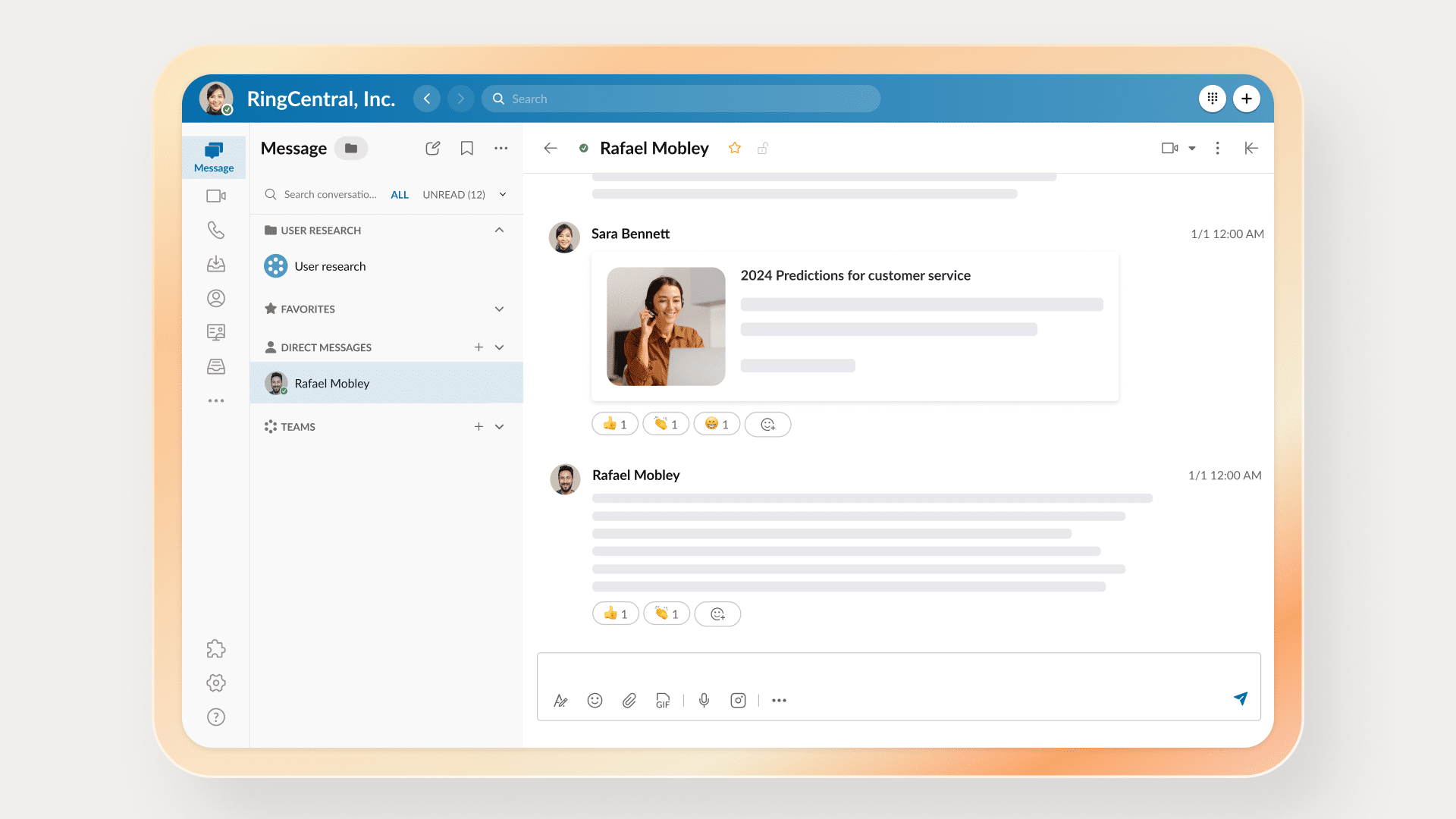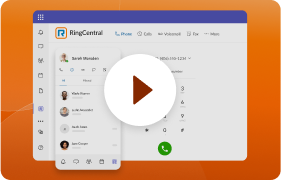Unified Communications as a Service (UCaaS) is a type of communications solution that’s been around for a while now. Flexible, mobile, and scalable, UCaaS platforms are made for modern businesses and if you’re not using one yet, you can be pretty sure your rivals are.
Once upon a time, a company could make do with just a landline-based telephone system. Those days are long gone. More recently, separate phone systems, email clients, and chat apps worked fine, but that time has passed, too. To foster the kind of collaboration needed to keep productivity high, especially if you have remote employees, it’s only a UCaaS solution that fits the bill.
UCaaS for Dummies — The only in-depth guide you’ll need
What is UCaaS?
UCaaS or Unified Communications as a Service is a type of cloud-based communications solution. It provides users with seamless integration of communication tools, including team messaging, voicemail, video conferencing, web conferencing, and audio conferencing within one single interface. For that reason, UCaaS platforms are increasingly favored by businesses that prioritize collaboration and productivity.
Easily accessible from all devices, UCaaS solutions are ideal for field employees, remote workers, and branch locations. You can collaborate and connect with your team from anywhere you fancy. The blend of different channels for business communications means you can also provide your team with a sense of connectivity no matter where they’re located. Many UCaaS providers even offer the option to get a custom phone number that’s memorable and aligned with your brand, enhancing your professional image across all communication channels.
That’s a potted UCaaS definition to get us started, but to fully understand the meaning of UCaaS, we should also look at a similar term—CCaaS—and how the two relate.
What is UCaaS and CCaaS?
UCaaS and CCaaS solutions are often discussed in the same breath. So, what is the difference between UCaaS and CCaaS, other than the first letter? In a nutshell, it’s about their purpose.
As mentioned, UCaaS platforms bring multiple communication channels together on one platform, and CCaaS solutions do that too. UCaaS tools, though, are designed for internal communication within organizations—think colleagues sharing ideas or collaborating on projects. CCaaS software, meanwhile, is to aid companies in communicating with their customers. The acronym stands for Contact Center as a Service; their cloud-based platforms for running customer contact centers.
Key functions of UCaaS platforms
The precise features of a UCaaS solution will differ from one platform to the next. However, there are some key functions which any unified communications software worth its salt should provide:
- Voice-based communication – A business UCaaS tool should offer everything a traditional phone system did and a bit more. That means it should be easy to call colleagues and other contacts, to hold audio conferences, and to transfer calls. You should also be able to record calls, have customizable voicemail, and perhaps voicemail transcription.
- Video calling – Modern businesses often rely heavily on video conferences and meetings. A UcaaS platform, then, must facilitate these and support them with features like closed captions and meeting transcripts, intuitive meeting controls, in-meeting chats, and other collaborative elements.
- Text-based collaboration – UCaaS platforms should also cater for team messaging, live chat, and other text-based collaboration. Such channels are key for easy collaboration of remote employees and are best supported by other features like file sharing and project management.
The future of UCaaS: Artificial intelligence-powered features
AI is here, and with it, the demand for smarter and more efficient communications systems is only going to keep growing.
Companies now also want their communications systems to support and take pressure off their teams. With AI-powered sentiment analysis, automated workflows, and more, current and future UCaaS platforms do just that. Artificial intelligence-powered collaboration features are likely to be the future of UCaaS, so it makes sense to choose a platform—like RingEX—that’s already embracing the technology.
How does Unified Communications as a Service work?
Looking at the technical side of things, the integral technology underpinning UCaaS is VoIP, which is used for internet telephony—transmitting calls as data packets rather than via landlines or cellular networks. Phone numbers and phone notifications operate via the universal Session Initiation Protocol (SIP).
As mentioned, UCaaS platforms encompass a number of tools aimed at facilitating communication between members, no matter where they are. This service is cloud-based and therefore fully accessible online through desktop and mobile apps. Additionally, the telephony of many UCaaS platforms can be extended to desk phones, giving users who are in the office and prefer to use a desk phone the flexibility to do so.
A user simply needs to log onto the platform, and they can make full use of the tools and applications at their disposal. The type of UCaaS features available will of course depend on the provider and package that you opt for.
Start your UCaaS journey today with RingCentral, a trusted provider of all-in-one business communications and software. With RingEX, you’ll be able to integrate your favorite channels into a single platform that encompasses messaging, video, and voice calls—along with all the other advanced features that a modern cloud-hosted VoIP system has to offer.
Benefits of UCaaS: 11 Ways all-in-one communications can help your business thrive
As the UCaaS definition highlighted, this technology is highly efficient and accessible. It’s therefore no wonder it has taken off among many businesses.
Below, we’ve listed some of the top benefits of unified communications and how UCaaS platforms can meet your business needs:
1. Cost efficiency
Handy for both small businesses and large enterprises, UCaaS is affordable and cost-efficient for a number of reasons To start, it doesn’t require large, upfront capital expenditures to procure the hardware to get your business phone system operational.
Since UCaaS is essentially a “service,” you also won’t need to fork out cash on any IT repairs or support—all of this will be covered by the system provider. By eliminating PBX, expensive on-premises updates and upgrades will become a thing of the past, so you’ll never again have to wait around for software and systems to be dealt with manually.
In fact, if you’re looking to quantify this saving, Forrester’s Total Economical Impact Study found that customers saved $2.68 million by opting for RingCentral rather than continuing with legacy systems.
What’s more, the study found that RingCentral’s integration capabilities with CRMs such as Salesforce increased efficiency and in part led to an estimated saving of $10.8 million.
Companies that replaced their existing systems with RingCentral’s all-inclusive solution with a business phone system, fax, SMS, conferencing services, and the interoperability of all these functions were able to eliminate the need for multiple vendors and simplify their technology solutions.
You can also increase your cost-efficiency using RingEX’s open-source application programming interfaces (APIs) to enable integrations with any of your existing software. Integrate with software such as Microsoft Teams or use Zapier to connect to over 3,000 additional apps instantly.
2. Ideal for global and hybrid teams
Scalability is another of the biggest benefits of UCaaS as it can be implemented for a global or hybrid team, regardless of location.
Phone lines and special features can be added to your existing UCaaS and phone system, helping streamline workflows no matter where your team dons their headset to start work. This provides opportunities for increased global growth and the chance to recruit internationally. With UCaaS, you’ll have all the tools and channels needed to collaborate and build a connected work culture.
3. Reliability
Since UCaaS providers are bound by service level agreements (SLAs), you can rest assured that you’ll be equipped with secure and reliable cloud communications that put your company’s privacy and protection first.
Guarantee both the safety of your data as well as your peace of mind with RingCentral. We’re fully regulated, HIPAA-compliant, and adhere to strict file protection. Oh, and we’ve delivered more than five consecutive years of 99.999% uptime.
4. Employee flexibility and mobility
One of the many perks of adopting UCaaS solutions is the added flexibility it allows your team, regardless of location.
As end users of the system, employees will be able to access a wide range of communication channels from any device they want (desktop or phone), so they’ll be able to work in a way that suits them best.
This flexibility makes for an overall better employee experience, leading to a happier and more productive team—it is also something needed by employees to keep customers happy and a crucial element of successful customer experience.
The fact that UCaaS can be operated from a single platform is also handy for employees, as they won’t need to keep multiple tabs open to perform different tasks or switch between applications.
5. Better team collaboration
Implementing UCaaS will not only streamline workflows and increase efficiency among your employees, it will also unify communications and bring your team together. This makes it ideal for businesses dealing with remote work or hybrid operations, since a sense of office culture and community can often get lost behind a screen.
With a UCaaS provider like RingCentral, your business will have access to a wide range of communication channels—including team messaging, live collaboration functions that facilitate team chats, video meetings, screen and file sharing, and webinars—so your workforce can stay connected.

6. Enhanced customer experience
Effective business communication isn’t only crucial to your team and internal operations; it’s just as vital to your consumers and external operations.
Cloud-based communications systems can provide an array of channels to communicate with customers. Customer service reps can reach out and respond to inquiries from all platforms (including social media) via a phone call, audio call, or even video—features like SMS and instant messaging add even more options to the mix.
The ability for customers to reach out to you via a range of channels makes for a better customer experience, as they can select the option most convenient for them. Not all customers will want to jump on a call; some might want to write a quick message or speak to a live chat agent.
You can also use RingCentral to identify and analyze all the data amassed from these interactions to discover which channels are most popular for customers to communicate through, making the most of these in future conversations.
7. Greater team productivity
Not just a tool to enhance the customer service experience, UCaaS can also increase productivity among your team, as all its features function from one platform.
Your team will have access to different communication channels such as video and audio, and other features such as messaging and web conferencing, in one place.
Here’s how it looks on RingCentral:
This means they won’t have to jump between different tabs to get things done and risk distraction and burnout. UCaaS essentially acts as the main communications hub for your team, so employees can easily interact and work collaboratively. RingCentral even offers a task management feature built right into the app to boost productivity.
8. All your data in one place
Many organizations have collected a wide range of apps and data storage tools over years, making the problem of data silos a common one.
With UCaaS, you’ll be able to break down these silos effortlessly, as all team members will have one central hub of communications. With all information and communications in one place, your team will feel more connected and aligned.
9. Ripple effect on revenue growth
We’ve already discussed the positive impact UCaaS can have on your customer service team, but did you know that this can have a ripple effect on your revenue and reputation as a business?
In the Forrester survey we mentioned earlier, a service user explained that once their business began using RingCentral, their average call handle time went from 7.5 minutes to 4.5 minutes [per call]. Imagine the impact this had on the quality of their customer service, not to mention the time (and therefore money) they saved.
Since UCaaS provides employees with the tools to work collaboratively and answer customer queries efficiently (from a range of different communication channels), they’ll be able to come up with strategic decisions and solutions to increase organizational growth more easily.
The more often your team produces results with customers, the more likely your business is to build a reputation as a company that puts the customer at the heart of its strategy—and, thereby, increase sales.
10. Secure communications
With UCaaS platforms accelerating innovation and sharing in productivity resources like chat, voice, and video collaboration, it’s crucial for organizations to scrutinize how their UCaaS vendor-of-choice handles security, data privacy, and compliance to mitigate the rise of serious financial and brand threats.
These threats are growing at a record pace, so ensuring your UCaaS platform provides a leading approach to mitigating these risks should play a primary role in your buying considerations
RingCentral offers enterprise-grade security, protecting your business and its data all along the way.

11. Ease of installation and use
The final great thing about UCaaS is that you don’t have to be a tech wizard to install the system for your business.
Since most of the groundwork is already done by your UCaaS platform provider, you’ll be able to migrate your system over to the cloud quickly and efficiently. You’ll also have access to easy-to-read user guides and manuals, as well as customer service reps to help solve any issues you face.
Top UCaaS providers: 4 Questions they should be able to answer
Whether you’re running a multinational enterprise or you’re a small business looking for a new communications solution, finding the right UCaaS provider isn’t always the easiest task.
The popularity of UCaaS solutions has boomed over the last few years, so there’s a lot of choice. Below, we’ve outlined some of the questions to ask of any provider of UCaaS services before you commit to their offering:
1. Is it scalable?
If you have a global or remote team, you’ll need to consider the scalability of the UCaaS platform you choose. The best UCaaS providers will be able to explain that their solution scales up and down instantaneously, adjusting to your business needs. Make sure to ask them, too, how easily features and business applications can be added to existing employees’ or a new hire’s phone system.
2. Is it secure and reliable?
A must for the current digital age, your privacy and data protection should be one of your top concerns when deciding between service providers. Make sure any Unified Communications as a Service provider you consider is verified, HIPAA compliant, and transparent about how it handles your data and privacy.
3. Is it made for collaboration?
Make sure you’ve found a service provider with effective collaboration tools that suit your teams. Ensure the provider you choose has a wide range of communication channels available with everything from audio calls and video conferencing to instant messaging.
4. Is it easy to use and to get help if you need it?
What is a UCaaS platform for, if not to make your teams’ lives easier? It simply won’t do that if it’s too difficult to use or has too steep a learning curve. Make sure to ask any prospective UCaaS provider about the intuitiveness of their platform. Is it designed to be user-friendly? What do they offer to support onboarding? How easily can you access customer support if you need it?
Best practices when switching to a UCaaS solution
So, you’re convinced of the benefits of UCaaS and you’ve identified the best UCaaS provider for your business. Job done? Not quite. You also need to ensure a smooth transition over to your new solution. Here are some best practices to get the most from unified communications as soon as possible:
Fully audit your existing tech stack
Make sure you know the tools and apps your teams are currently using for communication. Assuming you’ve chosen correctly, your new UCaaS solution should either replace or encompass all of them.
You’ll likely be phasing out old phone systems or chat apps, but there are other tools you may want to integrate into your new platform. For instance, perhaps you use a CRM or project management tool that you won’t want to part with. Fortunately, top UCaaS providers like RingCentral offer native integrations for such tools.
Get broad buy-in and keep your teams informed
If you are going to transition to a new communication and collaboration platform, make sure you get the buy-in of the people who’ll be using it—your frontline staff. Foist a new platform upon them out of the blue, and they’re likely to resent and resist the change.
As early as possible explain to your teams the decision you’re making and why, emphasizing the benefits the change will bring for them day-to-day. Make sure, too, to keep all your staff up-to-date on things like transition timetables and any new communication guidelines that may come with the new UCaaS platform.
Make the most of onboarding and support
Most UCaaS providers will offer guidance, advice, and support to help onboard you to their platforms. Make sure you take full advantage of what’s available so that all your staff know how to get the most out of the new solution.
When learning the new tool, encourage your teams to think about not only the tasks they need to do and features they need to use now, but also what might be beneficial in the future. If possible, try to examine onboarding materials and ask questions of the provider before you switch to the new platform, as well as once you’ve jettisoned your older tools.
UCaaS is the present and future for your business
The good news is, there are a lot of UCaaS platforms for you to explore for your specific business needs. Take your time, ask lots of questions, and take advantage of free trials and live demos.
Some UCaaS providers even offer a powerful, totally free offering; that’s a great way to ease into the UCaaS life. For example, you can get RingCentral Video Pro, from RingCentral for free. It includes our video conferencing and team messaging features, and is a great stepping-stone for small businesses not yet ready to take the plunge with RingEX.
View a free demo today to learn more about what RingCentral has to offer.
UCaaS FAQs
What does UCaaS stand for?
UCaaS stands for Unified Communications as a Service and is the name for solutions that seamlessly integrate communication tools and channels on one platform.
These tools include a business phone system, messaging (instant message, SMS, and MMS), voicemail, video conferencing, web conferencing, and audio conferencing. And all this is done on one easy-to-navigate interface accessible via the cloud.
What are the benefits of using UCaaS?
There are many benefits of UCaaS for organizations both large and small.
The flexibility and reliability it offers make it a great option for global and hybrid teams. Moreover, it fosters effective collaboration between team members, allowing for the free exchange of information, be it via a phone call, message, or video conferencing.
Unified communications tools increase employee efficiency and productivity and improve the customer experience you offer. The end result? Happier, more engaged employees and customers.
Since it’s all in the cloud, a UCaaS solution doesn’t require physical space— and the costs for physical equipment are eliminated. Additionally, any necessary maintenance is taken care of by the provider. Not to mention that UCaaS solutions are scalable, meaning they can adjust as the needs of your business grow.
Lastly, you don’t have to worry about the safety of your data; most UCaaS providers will employ tight security measures to ensure that any unauthorized persons cannot access any information stored or transmitted.
What do I need to be aware of when choosing a UCaaS provider?
Not all UCaaS providers are created equal, and businesses don’t all have the same needs. Which provider you opt for will depend on what you’re looking for.
Having said that, there are a few elements you should always consider when choosing a UCaaS provider:
- Scalability: How scalable do you need the service to be, and is that amount of scalability offered by the provider?
- Security: Make sure the service provided is up to date and compliant with the data protection and privacy laws.
- Collaboration tools: Do the collaboration tools included in the UCaaS platform align with your business needs and goals?
Updated Mar 31, 2025











